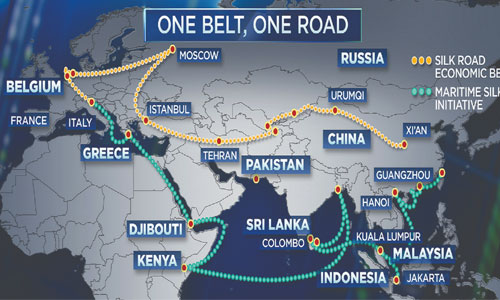This year marks the 5th anniversary of the Belt and Road Initiative (BRI) which aims to enhance economic ties and cultural exchanges between China and 65 other countries that collectively covers about 65 pc of the world’s population, one-third of the world’s GDP and about a quarter of all the goods and services the world moves.
The BRI was put forward by Chinese President Xi Jinping during his overseas visit in 2013 to connect Asian, European and African countries more closely and promote trade and transit between them. The BRI primarily consists of two parts: First, the economic belt, made up of six corridors including roads, railways, bridges and power plants and direct trade to and from China. The belt links China to Central and South Asia and onward to Europe. That is to say, the belt includes countries situated on the original Silk Road through Central Asia, West Asia, the Middle East and Europe. Second, the maritime silk road which is a chain of seaports from the South China Sea to the Indian Ocean and links China to South East Asia, the Gulf Countries, North Africa and on to Europe. The scope of the initiative is still taking shape. Until 2016, the initiative was known in English as the “One Belt and One Road Initiative” but the Chinese came to consider the emphasis on the word “one” as misleading.
For thousands of years, the Silk Road Spirit, i.e. “peace and cooperation, openness and inclusiveness, mutual learning and mutual benefit”, has been handed down from one generation to the next and promoted the progress of human civilization. The Silk Road Spirit is a historic and cultural heritage shared by many nations around the world.
The BRI megaproject calls for regional integration; construction of a global market and strengthening infrastructure, trade and investment. In other words, it is a platform to benefit all countries – regardless of being rich or poor, large or small, strong or weak – based on win-win cooperation and provide room for them to take part in global market. “The Belt and Road Initiative has five major roles, to promote policy coordination, facilitate connectivity, promote unimpeded trade and promote financial inauguration and more people-to-people advance in these areas.”
Through BRI, China is “not fighting over existing pie, but rather adding to the size of the pie by putting a lot of money to work around the world” so that all, including developed and emerging economies, could benefit from the fruit of the pie.
The funding institutions such as Asian Infrastructure Investment Bank, the Silk Road Fund and the New Development Bank have come into being to finance the BRI project and make this ambitious dream come true.
So far, more than 100 countries and international organizations have joined this initiative and 86 countries, including Afghanistan, have signed the Memorandum of Understanding (MoU) with China.
In 2016, Kabul government signed MoU with China and after a year it became the permanent member of the AIIB. Afghanistan also expressed its willing to have part in China-Pakistan Economic Corridor. To boost its economic ties with China, which is one of the largest foreign investors in Afghanistan, and enhance its connectivity, Afghan government will have to align its economic activities in the frame of BRI.
Afghanistan’s geopolitics and mineral resources are highly significant for the BRI and it will be able to regain its historical position as “center of the Asian crossroads”. To achieve this goal, Kabul government will have to hold counterinsurgency its top priority and resolve the conflict through peace talks or military deal. If militancy continues, the room for investment and trade will shrink, which will be a strong blow to the country’s economy.
A number of individuals believe that the BRI is similar to the US Marshall Plan, in which the US gave over $12 billion in economic assistance to help rebuild Western European economy after the end of World War Two. This comparison is due to the major role the BRI can play in the 21st century and promote global trade.
Countries along the BRI will be able to enhance their cultural bonds and people-to-people exchanges. Beside trade and investment, cultural exchanges are also highly essential in the current era of globalization. Countries and nations seek to carry their social values and national traditions through their culture. The BRI facilitates nations to exchange their cultural values so as to have mutual understanding and mutual learning.
In brief, BRI serves as a perfect platform for the world to boost their economy, exchange their cultural values, pursue multilateralism and win-win cooperation and seek peace through economic expansion.

